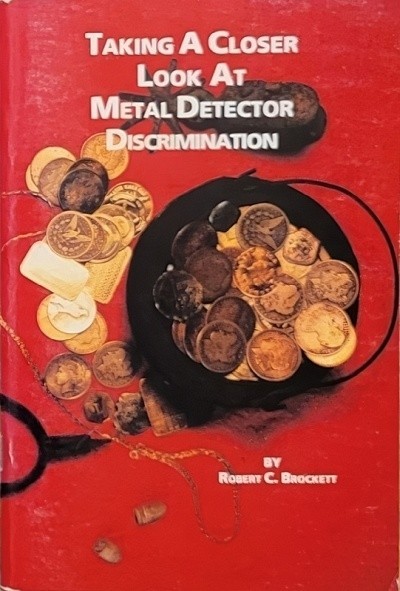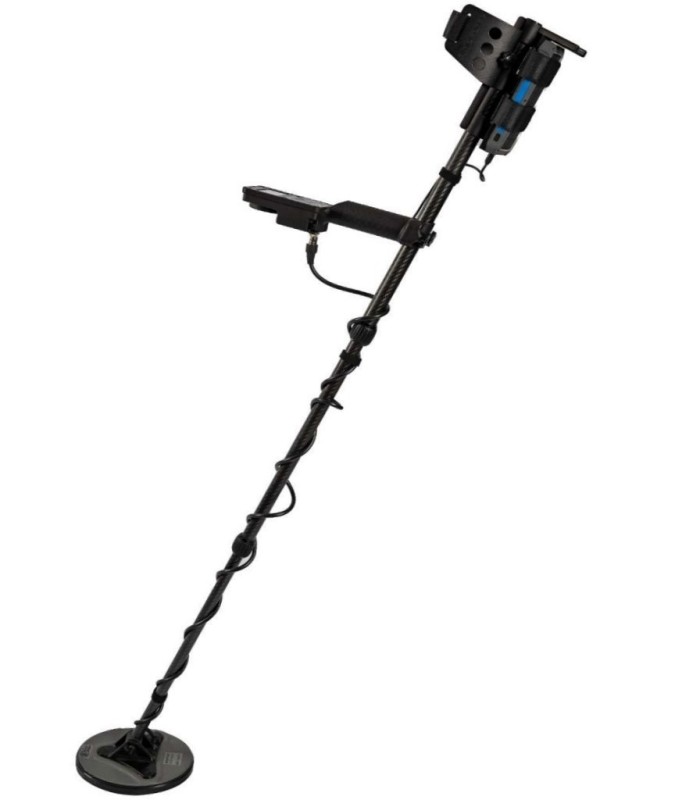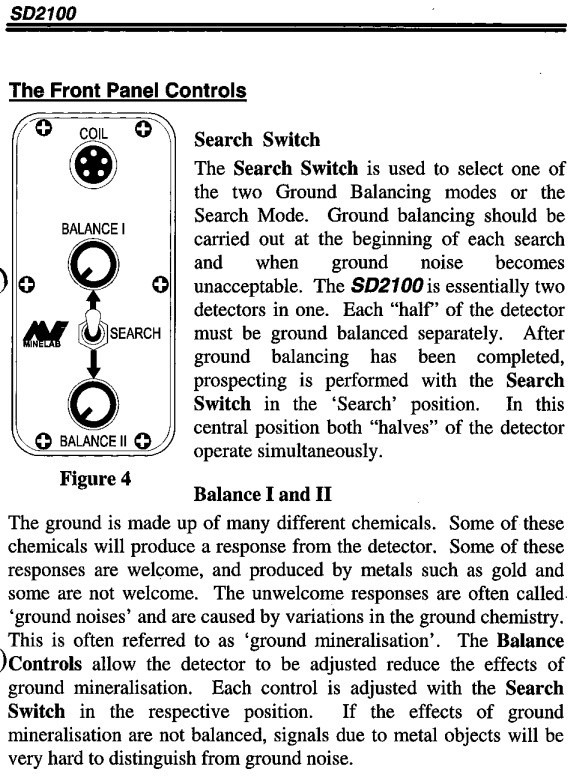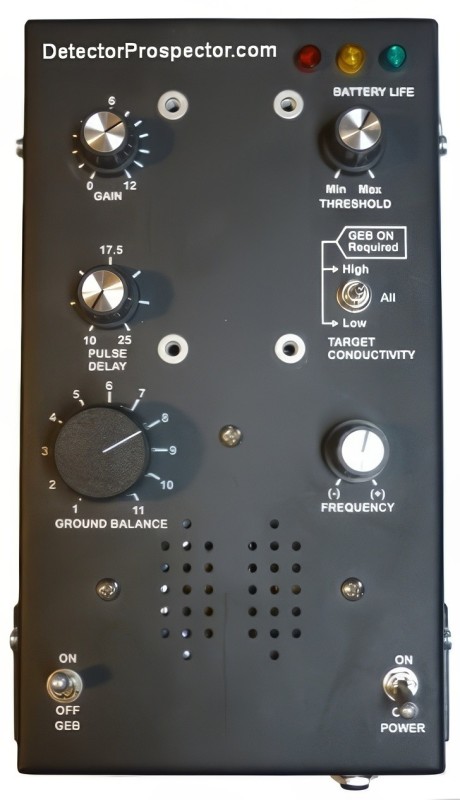-
Posts
19,755 -
Joined
Content Type
Forums
Detector Prospector Home
Detector Database
Downloads
Everything posted by Steve Herschbach
-

Hope For Video On Use Of E1500
Steve Herschbach replied to Whatsthetime's topic in AlgoForce Metal Detectors
-

Hope For Video On Use Of E1500
Steve Herschbach replied to Whatsthetime's topic in AlgoForce Metal Detectors
-

Hope For Video On Use Of E1500
Steve Herschbach replied to Whatsthetime's topic in AlgoForce Metal Detectors
-

Hope For Video On Use Of E1500
Steve Herschbach replied to Whatsthetime's topic in AlgoForce Metal Detectors
-

Hope For Video On Use Of E1500
Steve Herschbach replied to Whatsthetime's topic in AlgoForce Metal Detectors
-

First Gold Nugget Finds With The AlgoForce E1500
Steve Herschbach replied to phrunt's topic in AlgoForce Metal Detectors
I never used ground tracking until Minelab forced me to use it by giving me detectors with no option to turn it off. The rationale for doing so was less about it being the best methodology, than it was about the average detectorist not being up to the task of keeping their detector properly ground balanced. I am not saying there are not times when ground tracking is the best option. But I certainly also think there are times when tracking is not only not required, but is a less desirable option than fixed. A detector should offer both options, not force you to choose. But if forced to choose, I prefer not to use ground tracking if chasing tiny bits and as this seems to be the main focus of the E1500 it is a logical choice. -

Garrett Coil Design - Blunt Ends?
Steve Herschbach replied to timbus59's topic in Detector Prospector Forum
The flat back makes it less prone to tipping over when set down. The front is blunt because the back is blunt. It's different than the other guys coils. Kind of like Deeptech making some octagonal coils. No good reason for it, somebody just thought it looked cool and was different. I know of no reason why they are better than a normal pointy tip elliptical and would prefer those myself in the smaller coils. It is not a big deal with the 11x13 and I don't mind that design at all versus a round, maybe even prefer it. But the 7x11 I really wish was a pointy tip. Yes, the corners are hot on the mono, but not as hot as the tip and toe would be if it were a pointed tip. I think a pointed tip in a small coil is better for poking in nooks and crannies and for pinpointing with the tip. The 11x13 though would normally be a round coil, and here the squared off design I actually like. But a case can be made that round coils are the natural shape for any detector coil and give the most consistent detection pattern. -

Nokta Release Pending?
Steve Herschbach replied to HardPack's topic in Nokta / Makro Metal Detectors
I know what you guys are up to - just trying to pry a comment out of Dilek. Who knows, might work, always worth the effort. Of course it is coming, they have said that already. I would take a lack of official information or announcement as meaning it is not next week nor even next month. By the way Fisher, Garrett, Minelab, and XP are all working on new products and always will be until they go out of business. XP could surprise us with a new PI next month. Speculation about upcoming new product keeps the forum fueled and I appreciate that, but in the real world if you need something now, buy it. If not, wait. Procrastination almost always pays of in the world of technology. That huge OLED TV I have been eyeing for years just keeps getting better and cheaper, better and cheaper......... -

Nokta Release Pending?
Steve Herschbach replied to HardPack's topic in Nokta / Makro Metal Detectors
I don’t like these deals where we hear about but can’t get detectors for months if not years. Algoforce nailed it for Australia and NZ but here in the states it is the same old waiting game again.we all know Nokta is working on a PI but until they have something that is near ready for release there is little point in saying much more. -

Forget Algoforce, You Need This!
Steve Herschbach replied to Steve Herschbach's topic in Detector Prospector Forum
-

Nokta Release Pending?
Steve Herschbach replied to HardPack's topic in Nokta / Makro Metal Detectors
Nokta is late but has not missed the boat. They just need to be better than the Algoforce. Under $4000 we have the Garrett Axiom at $3995, 4.2 lbs, 6 coils, not submersible Minelab SDC 2300 at $3599, 5.7 lbs, one hardwired coil with three hard to install aftermarket coils, waterproof but floats like a cork, not really submersible Garrett ATX at $2120, 6.9 lbs, four overpriced coil with rod included options, fully submersible Algoforce at approx $1800 with coil and power pack, 4 lbs, dozens of coils options (over 100 if you count used), not submersible. If I were Nokta I would take the Legend package at 3.0 lbs and add an underarm power pack, leaving more room in the pod for electronics. Keep the whole thing fully submersible at 4 lbs. And just do what Nokta does in providing lots of coils themselves plus getting the aftermarket people on board. The glaring thing missing from the Algoforce is any kind of serious beach capability, and the beach hunters on Friendly Forum have already lambasted the machine for once again leaving them out of the equation. The only real submersible ground balancing beach PI at the moment is the Garrett ATX at $2120 and 6.9 lbs, crappy coil setup. So Nokta needs a 4 lb fully submersible PI at around $2000 that is at least as good as the Algoforce on gold. By all accounts so far the Algoforce is awesome on small gold, but only ok at best on larger targets. Even the manufacturer downplays the large item capability. So I would be sure the Nokta offering is good on small gold but be sure it beats the Algoforce on coin and ring size targets, playing to both beach hunters and nuggets hunters looking for larger nuggets. -

Forget Algoforce, You Need This!
Steve Herschbach replied to Steve Herschbach's topic in Detector Prospector Forum
I just love the part where he starts extending all the antenna - best comedy video I have seen in a while. -
Only $7500 or $5500 on sale!
-
The reality is simple. Most people want target id and other features like being waterproof the DeepTech lack. That means few people own them compared to the top sellers, and that means less discussion. They work just fine, great even, but people want what they want. There have been 19 threads since 2014 specific to DeepTech.... https://www.detectorprospector.com/tags/deeptech/
-

Some Things To Take Note Of With The Algoforce
Steve Herschbach replied to phrunt's topic in AlgoForce Metal Detectors
Why is it legal to sell LRL and all sorts of snake oil herbal "cures" and more? Because we have very weak consumer protection laws in the U.S. and fraud is basically legal. Even when a law is broken, the level of fraud now is so extreme it is impossible to chase them all down. New ones pop up daily. The internet has taken us back to the 1800s and if you are looking for something, no matter how outlandish, you can Google and find somebody willing to sell it to you. I get email scams daily. If there was ever a time for buyer beware it is now. -

Metal Detecting Books - Prices Reduced
Steve Herschbach replied to TC-AZ's topic in Metal Detecting & Prospecting Classifieds
The best book ever written on metal detector discrimination, explains in detail the history of exactly how the target id scale originally came about, lots of illustrative photos. One of the real classics in the field. -

Welcome To The New AlgoForce Forum!
Steve Herschbach replied to Lead Detector's topic in AlgoForce Metal Detectors
No it is not hard to track them. They are all tagged, all you have to do is click the tag and you get them all. This is nothing more than new detector excitement and only a handful of threads. I only create new forums in response to sustained interest and having at least 30 threads, which is just enough to fill one page of a subforum. In the long run it takes more than one model, as the Tarsacci forum died out after nine pages due to no new releases. Long story short I am more than happy to start new forums but we are not anywhere near that yet. The main thing needed will be a lot more people here who actually own one. -
Now you are singing my song Jeff. I almost never use a VLF. I just enjoy using a PI and doing old school hunt by ear detecting. I either dig it all, or if I am cherry picking I just dig what sounds good. And if you dig it all long enough, you do get a feel for what sounds good and what you can gamble in passing. If I nugget hunt I’m using a PI. If I beach hunt I use a PI. I even go to parks and coin hunt with a PI. I don’t relic hunt with a PI but that’s only because I don’t relic hunt. Yeah I dig junk but you VLF guys, are you trying to tell me you don’t? I know better. My main beef has been them being heavy expensive beasts but that’s changing. If I could only own one detector it would have to be a PI not a VLF. AlgoForce is going to change PI forever by setting a bar for what can be had for $2000 just like Equinox changed VLF forever. It will take maybe ten more years but the day of the $4000 plus PI dinosaur is coming to an end. More and better $2000 PI detectors will come to market and mark my words, someday we will have GPZ class performance for $2000.
-

First Gold Nugget Finds With The AlgoForce E1500
Steve Herschbach replied to phrunt's topic in AlgoForce Metal Detectors
Thanks for risking life and limb for us Simon! This all reminds me of the Axiom in a way. There was no reason to tell people who already own a 6000 they needed an Axiom. There is also no real reason why anyone with a 6000 needs a E1500. It’s for people who don’t have a 6000 and who don’t want to spend that kind of money. I can also see it for the person who has a 7000 and would like a second detector that is much lighter, can use smaller coils, and which overall costs less than some 7000 coils by themselves! But except for very odd situations like with maybe certain hot rock or EMI locations I just don’t see this detector outclassing the 6000 in outright gold detection. 6000 owners can pretty much just go on about their business and ignore all this, unless of course they are the sorts that just have to have another new toy to play with. There are a few of us like that. -
A PI can be made to be as sensitive to tiny gold as a high frequency IB detector but it is self defeating to do so. It would act exactly like the VLF, sensitive to hot rocks and hot ground as well as small gold. So no, the AlgoForce is not going to see gold as tiny as what a Gold Bug 2 or a Gold Monster can hit. Why bother? We already have those machines and if that’s what you want use them. But you know when you do you are missing larger deeper gold, and so maybe then you’ll want a PI. Different devices with different strengths and weaknesses. It’s like having a screwdriver and a wrench. There is no point in wanting your wrench to be a screwdriver.
-
All you can stand to know about Minelab timings.....
-
Just to clarify for people who don't know what dual channel and single channel PI is all about. Early PI did not ground balance per se, they relied on the pulse delay to take out the ground and saltwater. This was insufficient however for real bad ground commonly encountered by gold prospectors. I think it was Eric Foster who came up with the first widely sold PI with an actual ground balance. A simple knob as seen on the TDI which was originated in Erics Goldscan models. Unfortunately a PI ground balance setting creates a huge "hole" where certain targets get eliminated at common ground balance settings. Like 1/4 oz nuggets and certain gold rings for example. Bruce Candy came up with the idea of having two ground balances, each one creating a "hole" at different locations on the scale. The two "channels" as he called them were compared, and if one channel lost an item in the hole the other found it, and by comparing the two channels properly targets missed by single channel systems were revealed. This is all explained by Brent Weaver in the first link I gave in the last post. Single channel single ground balance PI creates two classes of targets based on the ground balance setting. Dual channel can create three classes. The early Minelabs actually has two separate ground balance controls that separates them from machines like the TDI. Then Minelab and Garrett learned to manipulate both channels simultaneously for better results. Yet the ability to manipulate the dual channels separately was lost, and I may have to pick up an old SD2100 to be able to play more directly with this stuff. Again, this is all explained in much greater detail at the second link I provided above. From the SD2100 manual:
-
No, White's never had a dual channel (two ground balance points) PI. Bruce Candy invented it and it became the basis for Minelab's SD2000 when White's passed on a chance to buy the tech from Bruce. One of the worst decisions in detector history. The TDI was licensed from Eric Foster much later in a bid to catch up, old school single channel. Garrett was actually second with dual ground balance channel PI with the Infinium, then ATX and now Axiom. A really great explanation from an actual engineer instead of me.... https://www.detectorprospector.com/topic/559-interview-with-brent-weaver-senior-design-engineer-garrett-metal-detectors/ PI discrimination based on eddy current decay is as old as PI and inherent in the tech. Every model with a pulse delay control is a "discriminating PI" and some companies like Garrett have marked and sold the control as a disc control for a long time. This is old stuff and if it were so simple as programming a few things it would have been done ages ago. Normal PI disc as employed with eddy current delay is based on both size and conductivity and even shape. You can only speak in generalities. There are huge amounts of overlap on target types and only useful in site specific situations with a knowledgeable operator. Ground balancing PI has a secondary form of discrimination based of the ground balance setting. The conductivity id is depth limited but the tones based GB disc goes to full depth. Fisher gave this a go with the Fisher Impulse AQ using the ground balance as a disc control instead of ground balance. Still you are basically correct that with high speed signal processing and comparison of the results of the two different id information streams available (Conductivity and GB Comparative) there is a lot more than can be done with PI disc in electronics. Right now it can be done by people who understand all this stuff by using audio and control manipulation, but 90% of the time VLF users are upside down and backwards in their thinking as regards PI disc. I don't know how many times I have heard people who don't know say the systems are depth limited and set up various straw man arguments about why PI disc is useless, when in fact it is being used all the time. Just ask anyone detecting for relics at Culpepper about PI vs VLF and how good a person can get at cherry picking targets at depth. Let alone guys like me that can cherry pick the vast majority of gold nuggets out of trashy old mining locations. I almost give up explaining it anymore but did make one last attempt at bringing all my posts over the years together into one linked set. It actually requires study and thought to understand as well as tossing all VLF preconceptions. For anyone who wants to give it a go, here it is. You have to read the entire thread plus the links I provided to get the whole picture. Now what AlgoForce brings to the table with the E1500 is advancing the Conductivity ID into giving us a 0-99 numeric reading, vastly improving on the Minelab blanking system and Garrett grunt system. This will probably be depth limited but will give a much finer degree of information one can use to make decisions. Coins in particular should give steady consistent readings. However, it may not be any better than a good multifrequency as far as depth. The dual tones the E1500 produces on the other hand will give two classes of targets to full depth very similar to the Minelabs, Garretts, and TDI. By using both in conjunction I anticipate a step forward in melding both deep target and shallow target id capability in a PI, but again the VLF naysayers should just ignore and be happy. I'm fed up with that lot. I will not debate with anyone how useful any of this is or not. I simply want to use my tools to full capability, not convince others they need to use them.
-
The bare basics of PI is the pulse delay. VLF is called Frequency Domain because it is frequency based. Pulse Induction is called Time Domain because it is time based. VLF continuously transmits and receives at a given frequency or frequencies. PI transmits, pauses, then receives. The pause is the Pulse Delay and varies in length - time. A current is induced in targets during the transmit phase, and the induced eddy current is what is picked up in the receive phase. This induced current rapidly decays - weakens - until it is gone. Different targets decay at different rates. Most ground and hot rocks decay faster than metal items. By setting the pulse delay long enough, you can ignore ground while still detecting those metal targets in the receive phase. Many PI detectors have a simple knob variable control that allows you to vary the pulse delay, and therefore what the machine picks up and ignores. Small targets and low conductive targets decay the fastest and so get eliminated first. The more conductive and larger the target, the longer it retains the eddy currents. There is no ferrous vs non-ferrous and ferrous is treated mainly based on size which in turn governs how long it retains eddy currents. It all revolves around time - how long is the pulse delay? Then Minelab came up with dual channel PI where you have two channels each running different delays at different times. It was not much of a leap for them to start calling these different mixes of channels and pulse delays "timings." This is a picture of the White's TDI Pro control set, pulse delay in middle left, range from 10uS to 25uS (microseconds)





